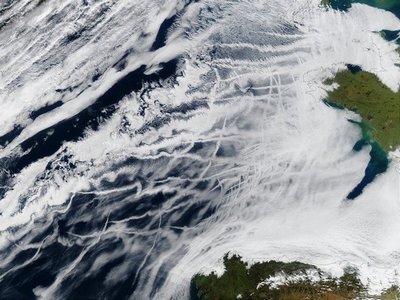July 8, 2010
Making clouds brighter: Could geoengineering slow climate warming?
Throughout history, natural events such as volcanic eruptions have periodically spewed tiny particles, called aerosols, into the atmosphere and cooled the Earth’s climate by reflecting sunlight back into space.
Today some scientists wonder whether deliberately injecting aerosols into the atmosphere could be a way to help offset greenhouse warming. The idea originated 20 years ago and has gained traction in the last few years because of the growing threat of climate change.
“I was very skeptical. I’m still very skeptical of the scheme,” said Robert Wood, a UW assistant professor of atmospheric sciences. “I find it very interesting, the idea that you can put minute particles into clouds and have an offsetting effect on greenhouse warming.”
Wood is among scientists undertaking two studies of different aspects of such “geoengineering,” a term applied to projects intended to deliberately manipulate the environment to try to offset changes in atmospheric chemistry that have led to climate warming.
One project, called Silver Lining, would use ships to spray a fine mist of salt particles from seawater into the atmosphere. Those particles would brighten existing clouds and create new ones to reflect more sunlight back into space. The work would take place in a small patch of marine air to study whether such a method could work and how much it might cost. It also will study critical questions about the impact of human emissions on clouds and climate, a key gap in information contained in climate models and in the understanding of climate change.
The program is being used as a model for national and international efforts to design and operate research programs for geoengineering.
The second project, supported by a grant from the UW’s new College of the Environment, will examine broader issues related to geoengineering, including the climatic, ethical and sociological implications of various geoengineering proposals. Even if a geoengineering solution proves feasible and costs are not prohibitive, Wood said, many unknowns could lead to unintended consequences.
“You’re essentially going to be moving large amounts of salt around the ocean and over land, and the question is what effect that has,” he said.
Throughout history, there have been any number of cataclysmic events that worked to cool the planet. Among them are the 1991 eruption of Mount Pinatubo in the Philippines, the 1883 eruption of Krakatoa in Indonesia and a succession of volcanic eruptions that led to 1816 being “The Year Without a Summer” in Europe and parts of North America.
A research paper published in 2006 examined how historic volcanic emissions of sulfur dioxide helped cool the planet and suggested the same effect could be achieved through geoengineering today.
“This alerted scientists that this could be done, and people began to realize that one nation, or even one wealthy individual, could choose to do this,” Wood said. But even if studies show it can be done, he said, there remains the question of whether it should be done. There are many considerations.
“What people don’t fully appreciate is that what we’re doing now with carbon dioxide is geoengineering. We’re changing the energy budget of the planet,” he said. “It’s inadvertent, but it is geoengineering.”
The effects of “cloud brightening” in the Silver Lining project would be limited and would have negligible impact on the overall world climate, Wood said. But scientists would get an idea whether such atmospheric modification is feasible.
In addition, he said, such a controlled experiment would provide a wealth of new data to help understand how pollution aerosols affect cloud systems. Those pollution particles, largely from sulfur emissions associated with burning of fossil fuels, already exert a cooling effect on the planet that scientists say could explain why the planet isn’t warming as fast as expected from human emissions of greenhouse gases.
Scientists have some sense of how cloud brightening might work because of previous studies that looked at the effects of ship exhaust on clouds. For example, the crisscross pattern of tracks from ship smokestacks was obvious in an image from NASA’s Aqua satellite in January 2003 as it passed over the Bay of Biscay off France and Spain. The tracks clearly added to the existing low-level clouds.
Some scientists believe adding sea salt particles to clouds is a more benign way of geoengineering than, say, pumping sulfur dioxide into the atmosphere, since the sea salt interaction with the air is a natural and continuous process.
“The idea is to do it faster than the ocean does it,” Wood said.
“I suspect that in the end the results might be less than people expect. We might find that geoengineering, this marine cloud brightening, is much less feasible than we imagined.”
In addition to Robert Wood, the Silver Lining research group includes Chris Bretherton of the UW; Hugh Coe, Keith Bower and Tom Choularton of the University of Manchester in the United Kingdom; Philip Rasch of the Pacific Northwest National Laboratory in Richland; John Latham of the National Center for Atmospheric Research; Stephen Salter of the University of Edinburgh in Scotland; Graham Feingold of the National Oceanic and Atmospheric Administration; Bruce Albrecht from the University of Miami; and Alan Gadian from the University of Leeds in the United Kingdom. Kelly Wanser, chief executive of a San Francisco-area software company, is coordinating the project.
Latham originated the idea of altering climate by injecting aerosols into clouds in 1990 when he was at the University of Manchester.
While the work would receive initial funding through the UW College of the Environment, a full-scale test likely would require $25 million to $30 million, Wood said.

